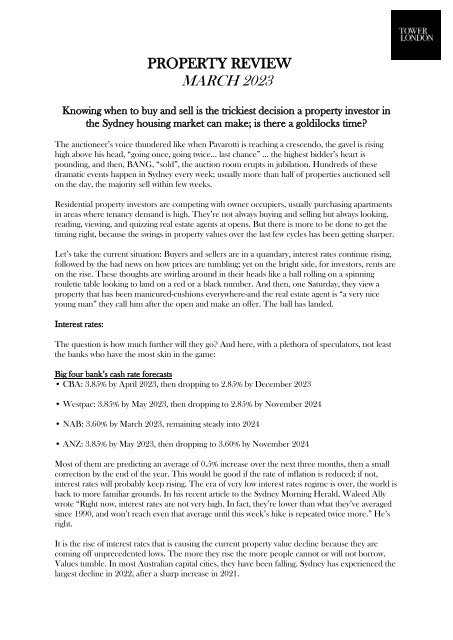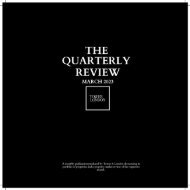March 2023 Quarterly Article - 'Knowing when to buy and sell is the trickiest decision a property investor in the Sydney housing market can make; is there a goldilocks time?'
Create successful ePaper yourself
Turn your PDF publications into a flip-book with our unique Google optimized e-Paper software.
PROPERTY REVIEW<br />
MARCH <strong>2023</strong><br />
Know<strong>in</strong>g <strong>when</strong> <strong>to</strong> <strong>buy</strong> <strong>and</strong> <strong>sell</strong> <strong>is</strong> <strong>the</strong> <strong>trickiest</strong> dec<strong>is</strong>ion a <strong>property</strong> <strong>in</strong>ves<strong>to</strong>r <strong>in</strong><br />
<strong>the</strong> <strong>Sydney</strong> hous<strong>in</strong>g <strong>market</strong> <strong>can</strong> <strong>make</strong>; <strong>is</strong> <strong>the</strong>re a <strong>goldilocks</strong> <strong>time</strong>?<br />
The auctioneer’s voice thundered like <strong>when</strong> Pavarotti <strong>is</strong> reach<strong>in</strong>g a crescendo, <strong>the</strong> gavel <strong>is</strong> r<strong>is</strong><strong>in</strong>g<br />
high above h<strong>is</strong> head, “go<strong>in</strong>g once, go<strong>in</strong>g twice… last chance” … <strong>the</strong> highest bidder’s heart <strong>is</strong><br />
pound<strong>in</strong>g, <strong>and</strong> <strong>the</strong>n, BANG, “sold”, <strong>the</strong> auction room erupts <strong>in</strong> jubilation. Hundreds of <strong>the</strong>se<br />
dramatic events happen <strong>in</strong> <strong>Sydney</strong> every week; usually more than half of properties auctioned <strong>sell</strong><br />
on <strong>the</strong> day, <strong>the</strong> majority <strong>sell</strong> with<strong>in</strong> few weeks.<br />
Residential <strong>property</strong> <strong>in</strong>ves<strong>to</strong>rs are compet<strong>in</strong>g with owner occupiers, usually purchas<strong>in</strong>g apartments<br />
<strong>in</strong> areas where tenancy dem<strong>and</strong> <strong>is</strong> high. They’re not always <strong>buy</strong><strong>in</strong>g <strong>and</strong> <strong>sell</strong><strong>in</strong>g but always look<strong>in</strong>g,<br />
read<strong>in</strong>g, view<strong>in</strong>g, <strong>and</strong> quizz<strong>in</strong>g real estate agents at opens. But <strong>the</strong>re <strong>is</strong> more <strong>to</strong> be done <strong>to</strong> get <strong>the</strong><br />
tim<strong>in</strong>g right, because <strong>the</strong> sw<strong>in</strong>gs <strong>in</strong> <strong>property</strong> values over <strong>the</strong> last few cycles has been gett<strong>in</strong>g sharper.<br />
Let’s take <strong>the</strong> current situation: Buyers <strong>and</strong> <strong>sell</strong>ers are <strong>in</strong> a qu<strong>and</strong>ary, <strong>in</strong>terest rates cont<strong>in</strong>ue r<strong>is</strong><strong>in</strong>g,<br />
followed by <strong>the</strong> bad news on how prices are tumbl<strong>in</strong>g; yet on <strong>the</strong> bright side, for <strong>in</strong>ves<strong>to</strong>rs, rents are<br />
on <strong>the</strong> r<strong>is</strong>e. These thoughts are swirl<strong>in</strong>g around <strong>in</strong> <strong>the</strong>ir heads like a ball roll<strong>in</strong>g on a sp<strong>in</strong>n<strong>in</strong>g<br />
roulette table look<strong>in</strong>g <strong>to</strong> l<strong>and</strong> on a red or a black number. And <strong>the</strong>n, one Saturday, <strong>the</strong>y view a<br />
<strong>property</strong> that has been manicured-cushions everywhere-<strong>and</strong> <strong>the</strong> real estate agent <strong>is</strong> “a very nice<br />
young man” <strong>the</strong>y call him after <strong>the</strong> open <strong>and</strong> <strong>make</strong> an offer. The ball has l<strong>and</strong>ed.<br />
Interest rates:<br />
The question <strong>is</strong> how much fur<strong>the</strong>r will <strong>the</strong>y go? And here, with a plethora of specula<strong>to</strong>rs, not least<br />
<strong>the</strong> banks who have <strong>the</strong> most sk<strong>in</strong> <strong>in</strong> <strong>the</strong> game:<br />
Big four bank’s cash rate forecasts<br />
• CBA: 3.85% by April <strong>2023</strong>, <strong>the</strong>n dropp<strong>in</strong>g <strong>to</strong> 2.85% by December <strong>2023</strong><br />
• Westpac: 3.85% by May <strong>2023</strong>, <strong>the</strong>n dropp<strong>in</strong>g <strong>to</strong> 2.85% by November 2024<br />
• NAB: 3.60% by <strong>March</strong> <strong>2023</strong>, rema<strong>in</strong><strong>in</strong>g steady <strong>in</strong><strong>to</strong> 2024<br />
• ANZ: 3.85% by May <strong>2023</strong>, <strong>the</strong>n dropp<strong>in</strong>g <strong>to</strong> 3.60% by November 2024<br />
Most of <strong>the</strong>m are predict<strong>in</strong>g an average of 0.5% <strong>in</strong>crease over <strong>the</strong> next three months, <strong>the</strong>n a small<br />
correction by <strong>the</strong> end of <strong>the</strong> year. Th<strong>is</strong> would be good if <strong>the</strong> rate of <strong>in</strong>flation <strong>is</strong> reduced; if not,<br />
<strong>in</strong>terest rates will probably keep r<strong>is</strong><strong>in</strong>g. The era of very low <strong>in</strong>terest rates regime <strong>is</strong> over, <strong>the</strong> world <strong>is</strong><br />
back <strong>to</strong> more familiar grounds. In h<strong>is</strong> recent article <strong>to</strong> <strong>the</strong> <strong>Sydney</strong> Morn<strong>in</strong>g Herald, Waleed Ally<br />
wrote “Right now, <strong>in</strong>terest rates are not very high. In fact, <strong>the</strong>y’re lower than what <strong>the</strong>y’ve averaged<br />
s<strong>in</strong>ce 1990, <strong>and</strong> won’t reach even that average until th<strong>is</strong> week’s hike <strong>is</strong> repeated twice more.” He’s<br />
right.<br />
It <strong>is</strong> <strong>the</strong> r<strong>is</strong>e of <strong>in</strong>terest rates that <strong>is</strong> caus<strong>in</strong>g <strong>the</strong> current <strong>property</strong> value decl<strong>in</strong>e because <strong>the</strong>y are<br />
com<strong>in</strong>g off unprecedented lows. The more <strong>the</strong>y r<strong>is</strong>e <strong>the</strong> more people <strong>can</strong>not or will not borrow.<br />
Values tumble. In most Australian capital cities, <strong>the</strong>y have been fall<strong>in</strong>g. <strong>Sydney</strong> has experienced <strong>the</strong><br />
largest decl<strong>in</strong>e <strong>in</strong> 2022, after a sharp <strong>in</strong>crease <strong>in</strong> 2021.
Yet <strong>property</strong> values rema<strong>in</strong> well above 2020 levels. Values will need <strong>to</strong> fall at <strong>the</strong><br />
same rate <strong>in</strong> <strong>2023</strong> <strong>to</strong> reach <strong>the</strong> levels of 2020.<br />
Source: CoreLogic, February <strong>2023</strong>.<br />
The above graph shows <strong>Sydney</strong>’s <strong>property</strong> <strong>market</strong> cyclical nature: just <strong>in</strong> <strong>the</strong> past five years, one <strong>can</strong><br />
see two r<strong>is</strong>es <strong>and</strong> three falls, <strong>the</strong> r<strong>is</strong>es are particularly steep; <strong>and</strong> <strong>the</strong> steeper <strong>the</strong> r<strong>is</strong>e, <strong>the</strong> sharper <strong>the</strong><br />
fall. Look<strong>in</strong>g at <strong>the</strong> graph now, you <strong>can</strong> p<strong>in</strong>po<strong>in</strong>t <strong>the</strong> “<strong>goldilocks</strong>” <strong>time</strong> <strong>to</strong> <strong>buy</strong> <strong>and</strong> <strong>sell</strong>; that <strong>is</strong>, <strong>sell</strong> <strong>in</strong><br />
December 2021, <strong>buy</strong> <strong>in</strong> December 2020. Did we know <strong>in</strong> December 2020 that prices we about <strong>to</strong><br />
jump more than 20%? No.<br />
Auction Clearance Rates:<br />
<strong>Sydney</strong> <strong>and</strong> Melbourne are hooked on auctions; real estate agents love <strong>the</strong>m because <strong>the</strong>y b<strong>in</strong>d <strong>the</strong><br />
vendor <strong>to</strong> a lengthy contract with a spectacular advert<strong>is</strong><strong>in</strong>g budget; <strong>and</strong> <strong>the</strong>n, all <strong>the</strong> stress <strong>and</strong><br />
emotional pressure on <strong>buy</strong>ers <strong>and</strong> <strong>sell</strong>ers, often result<strong>in</strong>g <strong>in</strong> a transaction. High percentage of<br />
auction clearance rates are encourag<strong>in</strong>g, but <strong>the</strong> direction of <strong>the</strong> trend <strong>can</strong> gauge <strong>the</strong> direction a<br />
particular cycle <strong>is</strong> head<strong>in</strong>g.<br />
Auction clearance rates are also cyclical; but here <strong>is</strong> <strong>the</strong> po<strong>in</strong>t: <strong>the</strong>y establ<strong>is</strong>h <strong>the</strong>ir<br />
trends before <strong>property</strong> values establ<strong>is</strong>h <strong>the</strong>irs, by about six months.<br />
If <strong>the</strong> general values of residential properties will r<strong>is</strong>e or fall <strong>in</strong> six months’ <strong>time</strong>, auction clearance<br />
rates trend l<strong>in</strong>e will show that now. It <strong>make</strong>s sense because <strong>buy</strong>ers <strong>and</strong> <strong>sell</strong>ers are not usually privy<br />
<strong>to</strong> where values will be <strong>in</strong> six months; as d<strong>is</strong>cussed above, <strong>the</strong>y might consider all <strong>the</strong> o<strong>the</strong>r fac<strong>to</strong>rs<br />
<strong>and</strong> <strong>make</strong> a judgement, or just let <strong>the</strong> “ball roll”.<br />
The rational <strong>is</strong> that if more properties are <strong>sell</strong><strong>in</strong>g at auctions every week; over <strong>the</strong> follow<strong>in</strong>g weeks,<br />
<strong>in</strong>evitably, some <strong>buy</strong>ers would have been out bidden; consequently, at <strong>the</strong> next auction, <strong>the</strong>y might<br />
pay a little more or <strong>buy</strong> a slightly lessor <strong>property</strong>. Th<strong>is</strong> gradual <strong>in</strong>crease <strong>in</strong> sales at auctions will<br />
ga<strong>the</strong>r momentum; <strong>and</strong> <strong>in</strong> a few months, values will start edg<strong>in</strong>g upwards. Conversely, <strong>when</strong> auction<br />
clearance rates are low <strong>and</strong> <strong>market</strong> sen<strong>time</strong>nt <strong>is</strong> down, <strong>buy</strong>ers <strong>can</strong> sense <strong>the</strong> desperation of <strong>the</strong>
<strong>sell</strong>ers <strong>and</strong> <strong>the</strong>ir agents as properties are passed-<strong>in</strong> one after <strong>the</strong> o<strong>the</strong>r, thus <strong>the</strong> cycle spirals<br />
downwards.<br />
Source: CoreLogic, February <strong>2023</strong>.<br />
Figure 1.1 <strong>is</strong> a graph on <strong>the</strong> Auction Clearance Rates for all capital cities for 10 years, but let’s take<br />
<strong>the</strong> last three years:<br />
• Let’s start with <strong>the</strong> pre-covid year: auction clearance rates climbed from 40% <strong>to</strong> 70%. From<br />
February 2018 <strong>to</strong> Feb 2020; <strong>property</strong> values were still fall<strong>in</strong>g from February <strong>to</strong> August 2019,<br />
it was not until September 2019 that values stated r<strong>is</strong><strong>in</strong>g, <strong>the</strong>y would have cont<strong>in</strong>ued r<strong>is</strong><strong>in</strong>g if<br />
not for <strong>the</strong> uncerta<strong>in</strong>ty caused by <strong>the</strong> P<strong>and</strong>emic.<br />
• Then by June 2020 we knew <strong>the</strong> auction clearance trend l<strong>in</strong>e, it was well on its way up.<br />
Hous<strong>in</strong>g values were still decl<strong>in</strong><strong>in</strong>g; but by December 2020 <strong>the</strong>y ricocheted through <strong>to</strong><br />
February 2022 r<strong>is</strong><strong>in</strong>g by about 23% across <strong>Sydney</strong>.<br />
• Auction clarence rates peaked <strong>in</strong> February 2021 <strong>and</strong> hovered high until mid-2021 <strong>the</strong>n<br />
started dropp<strong>in</strong>g; but not <strong>the</strong> values, until February 2022. If one was th<strong>in</strong>k<strong>in</strong>g about <strong>sell</strong><strong>in</strong>g<br />
<strong>and</strong> looked at <strong>the</strong> auction clearance trend <strong>in</strong> <strong>the</strong> latter part of 2021, one would have<br />
decided <strong>to</strong> <strong>sell</strong> by February 2022. At <strong>the</strong> <strong>to</strong>p of <strong>the</strong> <strong>market</strong>, <strong>when</strong> banks were still offer<strong>in</strong>g<br />
cheap mortgages.<br />
• Dur<strong>in</strong>g <strong>the</strong> last quarter of 2022 auction clearance rates hovered between 50 – 60% <strong>and</strong> <strong>the</strong>n<br />
<strong>in</strong>creased <strong>to</strong> 68% <strong>in</strong> February, yet values are clearly still fall<strong>in</strong>g. Should one <strong>buy</strong> now? <strong>is</strong><br />
<strong>the</strong>re a clear trend l<strong>in</strong>e yet?<br />
Auction clearance rate trends could well be <strong>the</strong> “Canary <strong>in</strong> <strong>the</strong> Coal M<strong>in</strong>e” for predict<strong>in</strong>g real estate<br />
values direction <strong>in</strong> <strong>Sydney</strong>-<strong>and</strong> <strong>in</strong> Melbourne-because of <strong>the</strong> high percentage of sales by auction.<br />
More research needs <strong>to</strong> be done <strong>to</strong> solidify th<strong>is</strong> proposition; <strong>and</strong> it only works for six months. It<br />
should only be applied <strong>when</strong> all <strong>the</strong> fac<strong>to</strong>rs mentioned above are considered with equal weight, <strong>and</strong><br />
clear advice from qualified f<strong>in</strong>ancial adv<strong>is</strong>ers. I am not one.<br />
John Tower<br />
John Tower<br />
L.R.E.A<br />
& Valuer


















